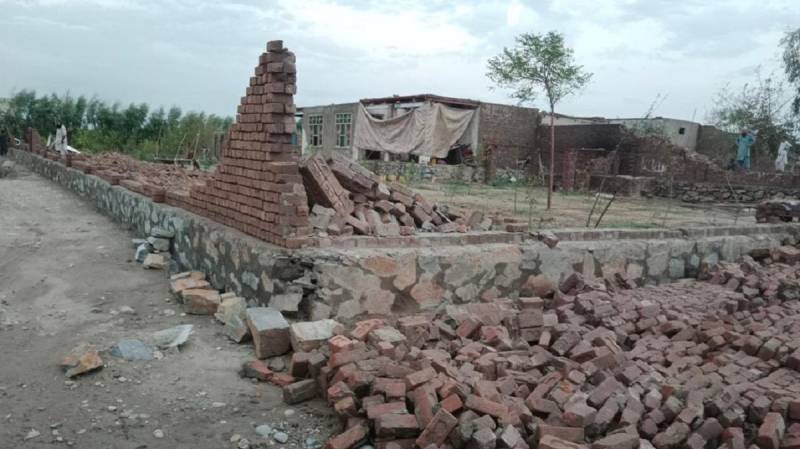
Heavy rains have triggered flash floods in the eastern districts of Afghanistan near the border with Pakistan.
The rains have thus far claimed 35 lives and injured 230 others in Jalalabad and areas of the border districts of the Nangarhar province.
Nangarhar's Information and Culture Department Head Quraishi Badloon said that the storms and heavy rains have damaged some 400 houses whose walls or roofs have collapsed, as well as uprooting trees, which has led to the casualties. He added that the dead and injured have been evacuated to the tertiary care hospitals in the province.
A camp at the Torkham border crossing with Pakistan was also swept away in the flash floods, affecting Afghans returning from Pakistan.
The UNHCR office in Afghanistan put the number of injured at 350 by rains and flash floods in Nangarhar based on information gathered by their assessment teams. The areas of Nangarhar most affected include the districts of Surkhrod and Behsud. Areas of Kunar and Laghman provinces were also affected by the flash floods.
The UN agency said that these regions have been hosting a high number of displaced Afghans and refugee returnees. It added that the areas had been designated as Priority Areas of Return and Resettlement (PARRs) by the UNHCR and that the agency was working with partners to provide essential protection and other services.
Afghanistan is highly prone to climate shocks, including floods and drought. In May, large areas of north, northeastern and western Afghanistan were hit by devastating flash floods, killing hundreds of people and destroying thousands of homes and large areas of agricultural land.
On the Pakistani side, heavy rains caused flooding in the Chitral river and triggered landslides in the valley's Reshun village.
Flood warning in Pakistan
Earlier in July, the National Disaster Management Authority of Pakistan (NDMA) issued a flood forecast that warned of significant rainfalls and flash floods.
"Significant rainfalls are anticipated in northeastern parts of Punjab, especially eastern rivers catchment areas, Potohar, Khyber-Pakhtunkhwa (KP), Southern Sindh and Azad Jammu and Kashmir (AJ&K)," the NDMA flood forecast read.
It further anticipated moderate to heavy rainfall, which may cause urban flooding.
"Likely to induce rapid rises in water levels in nullah's, triggering flash flooding across northern regions of Punjab (Sialkot/Narowal), KP and AJ&K."
In a separate weather impact advisory, the Pakistan Meteorological Department (PMD) said that monsoons and a westerly wave are forecasted to impact the upper and central parts of the country between July 11 and 16.
In Balochistan, PMD expected mainly hot and humid weather with rain, wind, and thundershowers expected in the eastern parts of the province, including Barkhan, Kalat, Khuzdar, Musa Khel, Shirani Ziarat, and Zhob.
In Sindh, hot and humid weather was predicted to prevail in most districts. However, rain, wind, and thunderstorms were expected in Jacobabad, Larkana, and Sukkur.
In Punjab, the overall situation was expected to remain wet with rain wind/thundershower (with sporadic heavy rainfall) likely in Attock, Bahawalnagar, Bahawalpur, Bhakkar, Chakwal, Chiniot, Dera Ghazi Khan, Faisalabad, Galliyat, Gujranwala, Gujrat, Hafizabad, Islamabad/Rawalpindi, Jhang, Jhelum, Kasur, Khanewal, Khushab, Lahore, Layyah, Lodhran, Mandi Bahauddin, Mianwali, Multan, Murree, Muzaffargarh, Nankana Sahib, Narowal, Okara, Pakpattan, Rahimyar Khan, Rajanpur, Sahiwal, Sargodha, Sheikhupura, Sialkot, Tala Gang, Toba Tek Singh, and Wazirabad.
In KP, rain, wind, and thundershowers (with sporadic heavy fall) are expected in Abbottabad, Bajaur, Bannu, Battagram, Buner, Charsadda, Chitral, Dera Ismail Khan, Dir, Hangu, Haripur, Khyber, Kohat, Kohistan, Kurram, Malakand, Mansehra, Mardan, Mohmand, Peshawar, Shangla, Swat, and Waziristan.
In Gilgit Baltistan (GB) and AJ&K, mainly cloudy weather with sporadic rainfall is likely in the Diamer region, Astore, Skardu, Gilgit, Ghanche, and Shigar.

